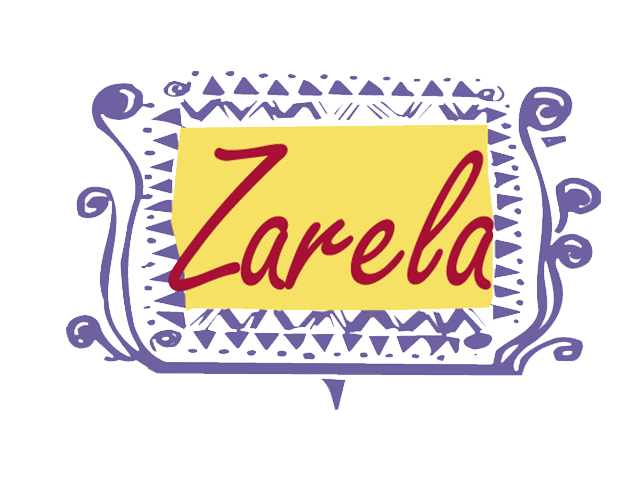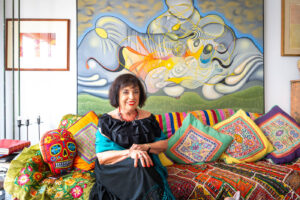I think if I could choose one event to dramatize the spirit of Mexican religion, it would be the Day of the Dead, or actually Days — Los Dias de los Muertos, November l and 2. To begin with, I assure you that this name does not sound in the least ghoulish or morbid to a Mexican. The Day of the Dead is perhaps our happiest, most life-affirming holiday. It is the celebration of memory, the time when we really feel we are speaking to and embracing those whom we have lost.
For me the Day of the Dead has been an important moment of the year since before I can remember. But even so I don’t think I took in the full dimension of meaning until I was a nineteen-year-old college student travelling — in an unchaperoned group of young people for the first time in my life! — to visit the ceremony on an island in Lake Patzcuaro, in the state of Michoacan. It was a time in the late sixties where educated Mexicans from all over were suddenly “discovering” the richness of Mexican culture and descending in droves on previously untouched spots. So were many European tourists. So I have to say that the Day of the Dead celebration on the island of Janitzio, probably the most famous in all Mexico, already had a strong note of commercialism. But for me it was an aastonishing and very moving pageant dedicated to the continuity of life.
We set out at dusk by motorboat, singing “Maria Isabel” to the strains of two guitars and one set of bongos and full of the famous local pescado blanco (white fish) caught in graceful “butterfly nets.” The lake was soon a vast, chilly sea of darkness lit only by a few guide lanterns on canoes making the same journey. But even from far off we saw a yellow-white glow coming from the cemetery. We disembarked into a crowd of visitors and vendors that I couldn’t match with anything in our sedate, private family celebration of the day. What a maelstrom! People were selling toys in the shape of laughing skulls, candies made like skeletons, chicle gums in all colors, black, yellow, or white candles, candleholders of shiny black pottery, copal (incense) burners. Streams of cheerful family parties pushed past us in the dark and confusion as if en route to a midnight picnic — which isn’t too far off the mark.
Janitzio is a rocky island, and the hilly cemetery might have been hard to navigate had it not been so full of lights. It was a carnival lit by thousands of candles. Hundreds of brilliant orange-yellow shapes — high arches or criscrossed squares — glowed in the darkness above every gravesite. They were cempasuchil, yellow marigolds, strung on ropes or strings, sometimes spelling out names. I had never seen or dreamed of such a fantasy of cempasuchil. Huddled in shawls and rebozos against the chilly evening, the people settled down to sing and drink and chat on the ground by the graves, half-shadowed revellers watched from the darker shadows by crowds of German or Dutch tourists. They were Tarascan Indians, and for them the strings of flowers were arches framing a passage for the souls of their friends or relatives to return to their earthly resting place on a kind of social visit. This is the whole purpose of the celebration.
Yes, these people were having a nice reunion with their loved ones! They had brought food for the purpose, including the favorite dishes of the deceased, and placed them — always in new pottery vessels bought for the occasion — before small altars erected at each grave with a picture of the loved one. They had also taken along any comforts the person might be missing in the next life, such as bottles of liquor and packs of cigarettes, toys and games and new clothes. I was astonished at the practical range of ofrendas (offerings) laid on freshly ironed white embroidered tea towels. Of course we had always visited the family graves on the Day of the Dead, but our celebration had been limited to scrubbing the tombstones and decorating them with zinnias or other autumn flowers and sharing a silent moment of communion.
The full-blown Day of the Dead ceremony, which I was seeing that evening for the first time, is most common in Mexico among the Indian peoples and the more rural mestizos. Four hundred years ago it probably would not have seemed strange in most places. At that time many peoples in Mexico celebrated a festival in August and September to ask the intervention of departed ones in warding off early frost. The idea that individual personalities continue after death and can intercede for the living with the great powers fitted well enough with the Spanish Catholic faith to survive the Conquest without much change. The holiday conveniently migrated through the calendar to coincide with the Catholic feasts of All Saints and All Souls Days at the beginning of November. But only the date changed. Nothing disturbed the original basis of the celebration, the belief that dead souls spend a brief period each year on earth on a kind of holiday. It’s an opportunity to catch up on those who are dear to you.
The Janitzio celebration begins after dark on November l and continues as a graveside vigil until dawn. In other villages there are usually two celebrations. November l, All Saints, is when the souls of the children arrive home in the villages and are met by welcoming committees of the local mayor and dignitaries along with the town band. The procession leads the children through an arch of cempasuchil at the gate of the cemetery and helps them find their graves. Each grave is decorated with images or structures of cempasuchil and turned into party sites with candies, toys, new clothing, and white candles, always in new pottery candleholders. On the next day, All Souls, the souls of the adults are welcomed in the same way (except that the candles are black or yellow). Those without surviving relatives are not forgotten — their graves are decorated by townspeople. In some communities the altar with the ofrendas is set up at home instead of in the cemetery.
Cempasuchil, the flower of the dead and a small replica of an ofrenda.
Beyond the favorite foods of the deceased, certain things are traditional for the Days of the Dead that date back to pre-Columbian times, including a sweet pumpkin dessert called calabaza en tacha and some form of tamales. In Janitzio people had brought a special kind of tamales with duck filling, from the Lake Patzcuaro wild ducks that are supposed to be not shot but harpooned for this occasion. But the most famous specialty of the day throughout Mexico is of European origin. In one of those typical Indian-Spanish intermarriages that have shaped our culture, the native peoples came to celebrate the Days of the Dead with a rich, sweet yeast bread on the model of the altar breads that are special feast-day offerings everywhere in Europe from Spain to Sweden. The Mexican imagination put a new spin of fantasy on the idea by shaping the loaves into different images. The famous pan de muerto (bread of death) comes in the shape of human figures, alligators, lizards, and other animals — but most often skulls and crossbones or teardrops and crosses, gaily decorated with colored sugar crystals. In many places, people bring the local mole and in Oaxaca tamales de amarillo are de riguer.
The most popular places for tourists to experience this magical holiday are Janitzio, Michoacan and Oaxaca (which has become quite touristy) and places around Mexico City but I personally will be going to a less known destination: Naolinco, Veracruz. You like the tradition but can’t travel just now? make your own. I’ll put up instructions and examples in the next two days . I am making the altar for Aytun Altindal, who was the love of my life, twenty years ago but with whom I remained very close until he passed away last year.
This is my official day of the Dead press release so it may seem familiar to you!



